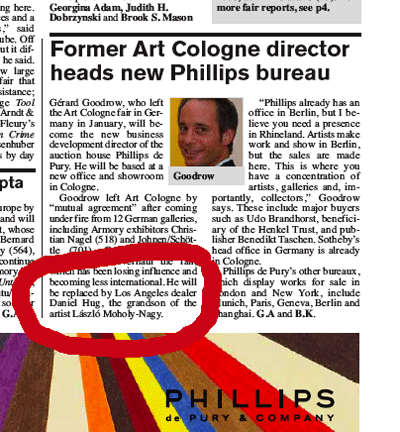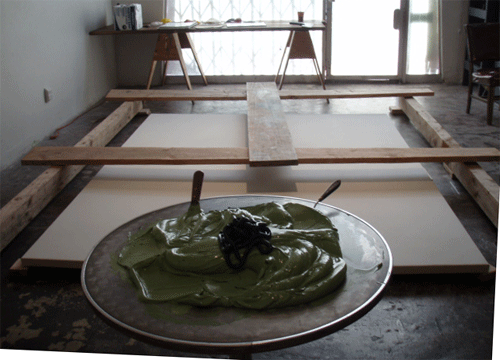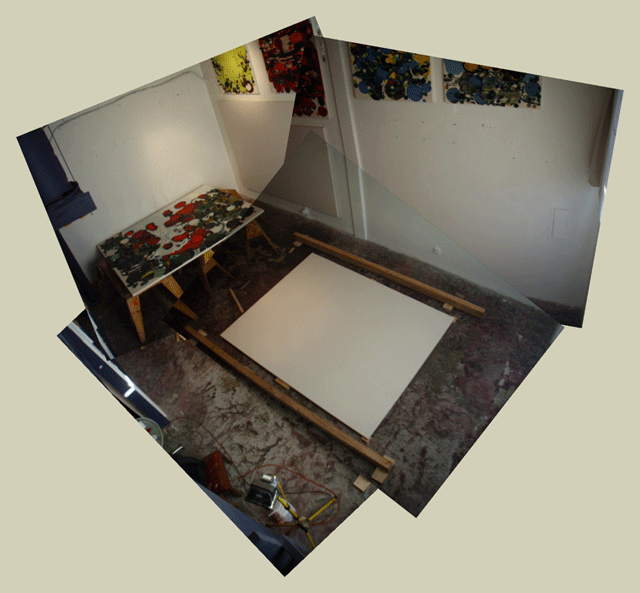March 31, 2008
Admin: Hang in There Folks
As I work into the final weeks before the show, I might not be able to do more than post an occasional image here and there along the way. Full throated blogging to resume once I knock out the next couple of paintings... or maybe three or more.
Two things for folks in Los Angeles:
I have told a few people earlier this year that the show will open on the 12th... but as the calendar sharpened up, my show at my gallery here in Los Angeles --Michael Kohn Gallery-- will actually open on Friday, April 18th. So check your calendars if you are planning to come by.
Also, I may not have your address to add to the mail list (stuff like this is not my strong suit), so send it in asap (my email address at the sidebar) and I might be able to get it into the pre-show process that will deliver an invite to the opening.
See you there! (If you're not in LA or you can't make it, I'll be back to full blog form by then to document the opening one way or the other.)
March 27, 2008
Lane Relyea at CSULB
Part 1 of 7
"... as Roberta Smith noticed in the New York Times last year: 'Solo shows resembling groups shows have now become generic'..."Craig Cree Stone invited me to hear Lane Relyea give a talk to the students at Cal State University in Long Beach yesterday. A great evening it was with a very nice after event dinner by the beach. The students I met there are very, very sharp. Craig, who has a double tenure at the Fine Art and the Indian Studies departments, teaches along with Chris Miles and Todd Gray.
Here is Lane's talk, six additional segments follow after the jump:
Part 2 of 7
Part 3 of 7
Part 4 of 7
Part 5 of 7
Part 6 of 7
Al final.
March 26, 2008
Go with Gusto.
Every single early morning in the big plaza of Los Angeles' ChinaTown you can be sure to find this group of old men playing Go with gusto.
Postscript: As a ChinaTown aside, I was talking to a local merchant yesterday, asking him how he was doing. He reported that the price of rice had tripled. Why? The demand to produce ethanol has displaced the rice crop worldwide. Along with higher oil prices affecting transport costs, food price inflation ripples worldwide.
My solution: Forget ethanol. BUY SCOOTERS instead! Taipei is the model.
Ahora

Al reverse aqui.
(I've been thinking about a painting I made a while ago in Tossa: King of a Sceptered Isle.)
LA DriveBy

Elysian Park on a late Sunday spring afternoon.
UPDATE: Andrew Hahn informed me that this particular Sunday afternoon was Easter Sunday, in fact. I plead studio monomania for my defense against a charge of being oblivious to the holiday calendar. I remember that this day I was riding home after an all nighter.
March 23, 2008
March 22, 2008
March 20, 2008
March 19, 2008
Lines, Faces.

I'm thinking about some things I did back in 2004
Happy Love

Dan Hug (eyeballing the camera) and I dropped into Phil Wagner's studio to check out a work in progress. He's painting from collages made from discarded photographs of minimalist installations (Michael Heizer?). The sign in the background eventually appeared in a birthday greeting for someone in Phil's family.
March 18, 2008
Peeled Paintings

I think I'll call these Peeled Paintings.
I paint onto store bought canvases, still with the plastic wrap on them. Then I let them dry until the surface is tough and then separate the paint from the plastic wrap support. I transfer it onto the canvas after I peel the wrapper off the back of the paint.
I happened upon this via a recent painting repair, the monads I was excising and replacing seemed to be perfect candidates for a transplant.
Skinning. Flesh. Carne. Carnitas.
Carnitas.
Maybe I should instead call this type of thing Carnitas?
(Henry Taylor had a hand in this one early on. I was showing him what I was doing and he daubed it a few times to feel the power.)
homage

I think we should build the space elevator at least in homage to Arthur C Clarke, if not for the prospect that it could open space up, the new frontier. Solar power has no limit in collection area in space, and if energy can be beamed down safely, then it would deliver the scale of energy we seem to need as time goes on. Blasting rockets should be seen as an antiquated method of entering space. It should be campaigned as the interstate highway program was. We should keep reaching for it.
All we need is insane, insane tensile strength.
Here is one of my early posts illustrating the
***

I don't have a lot of time for explicatin', moving through the rapids of my calendar as I am...
But while it's nice to watch the Space Shuttle live online, I can't help but think that while they are busy sawing off a little piece of foam, the freak out sweat-the-load levels going on there remind me of the (fortunately) hapless Richard Ried -the terrorist shoe bomber- and how afterward all the airport screeners had everyone doff our shoes at the gate. We tend to move as a society in such a blinkered manner...
In other words, why can't we imagineer our problem solving to anticipate various outcomes instead of anticipating only what had already just happened? We keep living in the recent past, even as we all hurtle into our asymptotic future.
Am I making sense here, people? Maybe not, but this level of clarity in this little rant is the best I can do on the fly!
Moving on...
My bigger point is: maybe it's time to shelve this space shuttle episode and...
...move on...
...to...

IT'S TIME TO BUILD THE SPACE ELEVATOR, PEOPLE!
HELL YEA!
(Artwork image taken from LiftPort.com.)
Here's a snippet from an article in Space.com:
Forget the roar of rocketry and those bone jarring liftoffs, the elevator would be a smooth 62,000-mile (100,000-kilometer) ride up a long cable. Payloads can shimmy up the Earth-to-space cable, experiencing no large launch forces, slowly climbing from one atmosphere to a vacuum.
Earth orbit, the Moon, Mars, Venus, the asteroids and beyond - they are routinely accessible via the space elevator. And for all its promise and grandeur, this mega-project is made practical by the tiniest of technologies - carbon nanotubes.
Lots of good information at LiftPort.com:
The proposed Space Elevator bears very little resemblance to the space elevators of science fiction. Rather than a cable as big around as a sequoia, it will be about the size of a sheet of paper. Rather than huge trains running up and down on magnetic tracks, climbers the size of a dump truck will grip the ribbon between two rollers and pull themselves up. Rather than a captured asteroid as a counterweight, it will use the left-over construction equipment.
For more links:
Check out this site, Blaise Gassend's super geek treatment (remember, the geeks brought us the internet among other things). Be sure to click around, there's a lot of basic homework done there.
Check out the Wikipedia page for the basic concept. (Image source). Pretty good stuff.
Here's the space elevator blog.

***
From one end of the scale to the other....
It's all about the nanotechnology, yo:
Nanotechnology has been harnessed to kill cancer cells without harming healthy tissue. The technique works by inserting microscopic synthetic rods called carbon nanotubules into cancer cells.
When the rods are exposed to near-infra red light from a laser they heat up, killing the cell, while cells without rods are left unscathed.
UPDATE:
I informed liftport.com that I was using their image, and they send their blessings:
Thanks for your support, the blog looks great. I don't know if you knew, but that's the image that's going to be on the front cover of our book coming out in September.Take care,
Michael J. Laine, Liftoport.com***
I second Michael's reply. Thanks for caring and for blogging.
Every expression of support for the space elevator concept, and Liftport in particular, means a great deal.
Ad astra.
--
Brian Dunbar
System Administrator
Liftport
Heads up!
A Real Grimace

I met up with our old freind Craig last night, and he returned my favorite book, Dark and Bloody Ground. I found a description in a googled eBay page: Edited and with an introduction by Victor Guerrier. Though born in Spain, Perez Lopez was raised in France and thus became a member of the International Brigades serving as a guerrilla leader of the First Death Platoon under the name of "El Mexicano".
Here at the end of an early chapter titled "First Jobs", Lopez relates how in his mid teens, he worked in the circus as a clown:
I traveled in a beautiful trailer with three clowns who taught me the trade. We did not have to set up the tent. As soon as we arrived we practiced our roles. First, they taught me how to take slaps. Usually the slaps are for fun and you make the noise by clapping your hands together. But they dealt me real slaps and I made a funny grimace. That was just what they wanted: it was the only way to learn to make a real grimace. It was the same with falling off a bench. First they had me sit on a bench, then without warning, they shoved me off, hard. I hurt myself falling and got up bent double with pain. Again that was what the wanted: my contortions were natural. Then they taught me to fall, throwing my elbows out behind at just the right moment. Then it was falling on my head, covering it with my arms at the last moment to protect it. Finally, we rehearsed a number. Once we knew it well, always making the same gestures, the same grimaces and saying the same words, there was nothing to doing it before the public. I made people laugh and was a great success. The director was very pleased. We traveled around France for a month. But when the circus went to Marseille to embark for South America, I left it and went back home.This adventure made me a celebrity in my friends' eyes. They were not the flower of the town. With them I had become a steady customer of the local whorehouses. I knew all the girls. Sometimes their pimps would ask me to place girls for them in N?mes, Arles, Aix or Marseille. The police started keeping an eye on me.
At the time the Spanish Republic was beginning its propaganda campaign to get young Spanairds in France to enlist in the army. I could see myself in helmet and bandolier. That didn't appeal to my grandmother. To change my mind, she decided that the whole family would leave for Algeria to visit my successful great-uncles there.
March 17, 2008
LA DriveBy

Grand Avenue looking east at Coop Himmelb(l)au's new school for LAUSD. I have no idea what we are looking at, some strange spire for a bureaucratic temple? With a slide? (See "High School #9.)
March 15, 2008
Ahora

The past 5 days 4 days 3 days went to taxes (two days for the lethargy of scattered wits). A blizzard of receipts it was. My aversion for bureaucracy (#12) didn't help at all.

March 11, 2008
a gleaming stripe across the sky

"...a fireworks display with no sound...":
One moonless night, while flying a routine training mission over the Pacific, I wondered what the sky would look like from 84,000 feet if the cockpit lighting were dark. While heading home on a straight course, I slowly turned down all of the lighting, reducing the glare and revealing the night sky. Within seconds, I turned the lights back up, fearful that the jet would know and somehow punish me. But my desire to see the sky overruled my caution, I dimmed the lighting again. To my amazement, I saw a bright light outside my window. As my eyes adjusted to the view, I realized that the brilliance was the broad expanse of the Milky Way, now a gleaming stripe across the sky. Where dark spaces in the sky had usually existed, there were now dense clusters of sparkling stars. Shooting stars flashed across the canvas every few seconds. It was like a fireworks display with no sound. I knew I had to get my eyes back on the instruments, and reluctantly I brought my attention back inside. To my surprise, with the cockp lighting still off, I could see every gauge, lit by starlight. In the plane's mirrors, I could see the eerie shine of my gold spacesuit incandescently illuminated in a celestial glow. I stole one last glance out the window. Despite our speed, we seemed still before the heavens, humbled in the radiance of a much greater power. For those few moments, I felt a part of something far more significant than anything we were doing in the plane. The sharp sound of Walt's voice on the radio brought me back to the tasks at hand as I prepared for our descent.
March 9, 2008
March 4, 2008
Monadology

Aaron recently sent me James Elkin's What Painting Is, it's chock full of nuts.
(page 46)
I.
To begin counting, it is best to start with one. The Bible opens with a primal unity: In the beginning all elements were a single chaos. Alchemists often speak about the world around them as if it were still that ancient chaos "without form", and they imagine their purpose to be the regathering of the fallen parts of the world into a new unity. The "All in all" (omnia in omnibus), a favorite alchemical invocation, is an attempt to compensate for the bewildering variety of the world, by swirling every conceivable object into the first undifferentiated unity. Omnia in omnibus also gestures toward the interconnection of all things, as if to say, Even though there are two marks, or an infinity of marks, they are only a singe mark. The perfectly fused substance is the unwavering goal of alchemy, and it is also alchemy's starting point: just as the world began in a single chaos, so it will end in impeccable perfection. The best name for this congealed perfection is a monad...
I like the close read of paint. The next couple of pages I found to be most interesting/challenging. Originally, I was coming from Leibniz's formulation. Elkins takes this into interesting territory.










